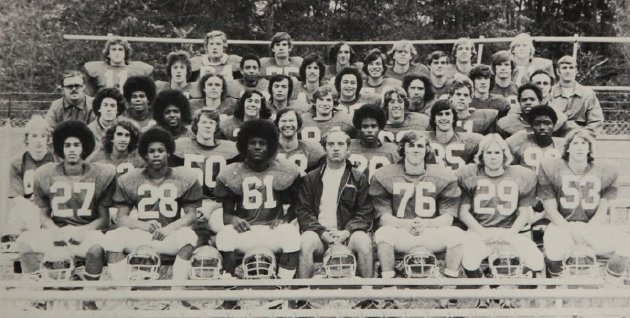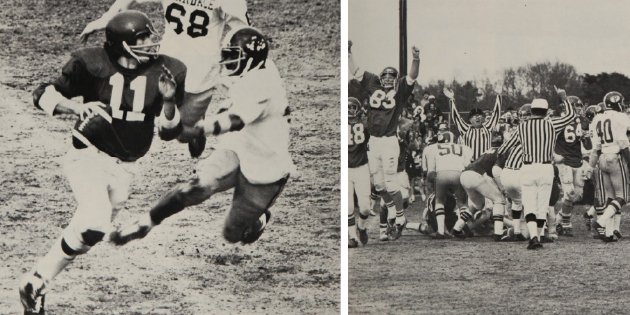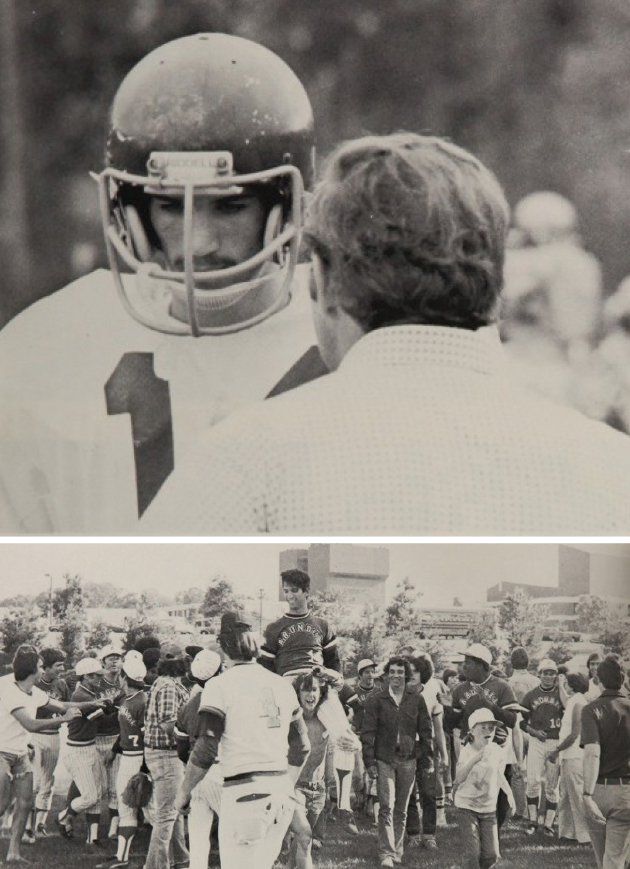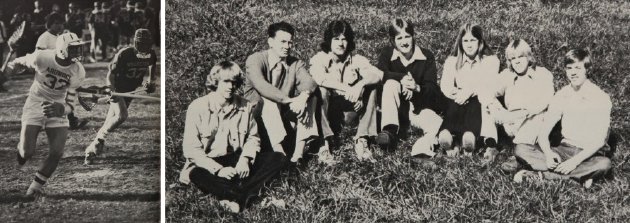×
By Jonathan Yates
brbrUnlike so many other sports debates, this did not start off as a fight at the local dive bar, but rather, in the periodicals room of the Crofton Library.
brbrI was reading a recent Sports Illustrated, which had the cover story about the 25th-anniversary of the Permian High School Panthers football team from Odessa, Texas, which inspired the book, Friday Night Lights by H.G. Bissinger, and, later, the movie and television series by the same name. As it states in Wikipedia, “Permian High School and its football team, the Permian Panthers, had a long, rich history of winning in Texas’ 4A and 5A division, having won championships in 1965, 1972, 1980, and 1984.” The article was in a “where are they now” motif, following up on the players more than a quarter-century later.
 The 1976 Arundel High School Football Team.
The 1976 Arundel High School Football Team.
brbrNot because they had done so well, but the exact opposite. Only one had gone on to play major college ball. I immediately thought about the Arundel High School team, when I was in high school, that won the state football championship in the fall of 1975–76 and sent players to major collegiate programs, such as: Brian Weisberg to USC, where he played in The Rose Bowl; Don O’Shea, who played for a championship team at Delaware; Don Qubecka to the University of Georgia, where he played in The Sugar Bowl; Sam Johnson to the University of Maryland, where he played in The Sun Bowl and was later drafted by the Detroit Lions; and Mike Lyons, Gary Collins, and Gene McAphee, all of whom went to Morgan State, where they played in the MEAC playoffs on one of the best teams in the history of that storied program (that itself has sent many players to the NFL such as Hall of Famers Willie Lanier and Leroy Kelly, and Raymond Chester, the Baltimore Colt who, many believe, should be in the Pro Football Hall of Fame).
brbrThat 1976 class also won the state championship in baseball that spring, with many players taking their game to the next level thanks to the coaching of the legendary Bernie Walters.

brbrBut the overall athleticism of those 1976 football and baseball squads, and their accomplishments in sports after high school, speak to how great Arundel was in sports that year.
brbrNeal Herrick, the starting quarterback for the state championship football team, pitched in the game that won it all for Arundel; and later played baseball for the University of Maryland, and then in the Baltimore Orioles farm system. Chuck Hebron started at second base for the baseball team, guard in basketball, and at running back for the football squad. In college at Salisbury University, he still holds the record for receiving yards in football, and for stolen bases in baseball with 125. The player with the next most career stolen bases for Salisbury only has 82.
brbrThe basketball team had done well too, going deep into the playoffs, the winter of ’75–76.
brbrBut it probably would have won the state championship, too, if the best big man in Maryland for his class, Chris Gildea from Crofton, had not been starting for the renowned basketball powerhouse DeMatha Catholic High School. He was previously in the summer league that played at Lake Waterford in Pasadena, in addition to his playing in several incredibly competitive other ones that pounded the pavement in Washington, D.C. Chris played junior high school ball for Arundel, but it’s tough to say “No” when Morgan Wooten, the fabled basketball coach at DeMatha, comes calling for you to play on his high school team. Like every other player who ever took the floor for DeMatha, Chris, too, won a college scholarship, anchoring the front line for the University of New Hampshire for four years.

brbrDr. Michael Lyons, who now serves as the Assistant Principal at Old Mill High School, was a logical focal point for this article because he won “Most Athletic” at Arundel for the Class of 1976, and went on to more glory for Morgan State, both in football and wrestling. In football, he was the starting nose tackle on the “Quiet Storm” defense that took Morgan State to the playoffs for the first time in 23 years, and sent several players to the pros. Lyons, who tried out for pro football, also made it into the NCAA wrestling championships.
brbrWhen asked what made the sports program that year at Arundel the best in the country, a question with a premise that he, unsurprisingly, agreed with, Lyons immediately responded with, “We had a collection of guys who were winners. They all won on different teams from different sports. It was a collection of winning athletes who just did not know how to lose!”
brbrThat basically spoke for the entire athletic department for the Class of 1976 at Arundel.

brbrWhat the Class of 1976 had was a spirit not there before or since. After that, Old Mill and Meade divided many fine athletes, and great friends, too. Old Mill opened in 1975. Fort Meade in 1977. While seniors graduated with their class at Arundel, there were many fine athletes playing for Meade and Old Mill who graduated in 1977, who would have been playing for Arundel if they had been in the Class of 1976, contributing to success on the field and spirit in the halls and classrooms.
brbrMuch of that spirit came from the unparalleled success of the sports teams.
brbrThe winning on the fields for Arundel, in large part, emanated from excellent youth programs in Crofton, Fort Meade, and the Gambrills/Odenton area. State Senator Ed Reilly, who represents District 33 in Anne Arundel County in the General Assembly, spent 20 years coaching soccer and lacrosse for boys and girls in the Crofton Athletic Association, where he lives. During that span he got to watch future professionals such as A.J. Francis of the Miami Dolphins and Kyle Beckerman of Real Salt Lake and the United States World Cup soccer team come up through the ranks in those youth leagues.
brbr“The Class of 1976 shows what happens when communities work together to nurture young children into young adults that win athletic championships,” Reilly declares. “Arundel and other public school teams would have been better, too, but there are many fine private schools in the area with excellent sports programs, also. Products from the Crofton Athletic Association go on to not only lead Arundel to victory, but also Archbishop Spalding, DeMatha, Gonzaga, and a host of other private schools such as Severn and St. Mary’s. The Class of 1976 at Arundel proves what I have always contended: That Maryland has the best high school sports in the country with Anne Arundel County as the epicenter!”
brbrThe excellence of Arundel has been established in many sports other than just the big three of football, basketball, and baseball.
brbrJoe Heil was setting records for the Naval Academy Junior Swim Team (Arundel does not have a pool). He later went on to captain the swim team at the United States Naval Academy, where he set several records for long distance freestyle events before graduating in 1980. Nancy Maunder was probably the best golfer ever from Arundel, going on to be a professional. Jeb Scannel, a cornerback on the football team, was awarded a lacrosse scholarship to the University of Maryland. Overall, the wrestling squad has produced 16 state victors, with the overall team grappling two. The girls’ basketball team has won four state crowns, with the men capturing one. “Back in the day,” the boys track team raced to the state title in ’70, ’71, and ’73.

brbrThe movement is to smaller schools. With fewer students, the odds of having more great athletes are reduced significantly. There is also the trending focus on one sport, which results in fewer three-sport athletes.
brbrChuck Hebron started in football, basketball, and baseball for the Class of 1976. Overwhelming in athletic skills, he was not in size. Today, he would probably play baseball year-round, in chase of an eight-figure salary in the pros.
brbrThe world will never know if the Class of 1976 from Arundel could have taken on challengers from around the country and firmly established itself as the best school for sports that year. But it is tough to imagine any others matching up to the Wildcat squads in green and white and emerging victorious in year-round clashes. If this article has not made that point—that the success of Friday Night Lights and its vaunted Texas powerhouse comes up short in sending its players to the next level—then the truest test, and the one in which Arundel excelled in all sports, more than makes it clear about the supremacy of the Class of 1976.
brbrUnlike so many other sports debates, this did not start off as a fight at the local dive bar, but rather, in the periodicals room of the Crofton Library.
brbrI was reading a recent Sports Illustrated, which had the cover story about the 25th-anniversary of the Permian High School Panthers football team from Odessa, Texas, which inspired the book, Friday Night Lights by H.G. Bissinger, and, later, the movie and television series by the same name. As it states in Wikipedia, “Permian High School and its football team, the Permian Panthers, had a long, rich history of winning in Texas’ 4A and 5A division, having won championships in 1965, 1972, 1980, and 1984.” The article was in a “where are they now” motif, following up on the players more than a quarter-century later.
brbrI was stunned to read about what the players had gone on to accomplish in football.
brbrNot because they had done so well, but the exact opposite. Only one had gone on to play major college ball. I immediately thought about the Arundel High School team, when I was in high school, that won the state football championship in the fall of 1975–76 and sent players to major collegiate programs, such as: Brian Weisberg to USC, where he played in The Rose Bowl; Don O’Shea, who played for a championship team at Delaware; Don Qubecka to the University of Georgia, where he played in The Sugar Bowl; Sam Johnson to the University of Maryland, where he played in The Sun Bowl and was later drafted by the Detroit Lions; and Mike Lyons, Gary Collins, and Gene McAphee, all of whom went to Morgan State, where they played in the MEAC playoffs on one of the best teams in the history of that storied program (that itself has sent many players to the NFL such as Hall of Famers Willie Lanier and Leroy Kelly, and Raymond Chester, the Baltimore Colt who, many believe, should be in the Pro Football Hall of Fame).
brbrThat 1976 class also won the state championship in baseball that spring, with many players taking their game to the next level thanks to the coaching of the legendary Bernie Walters.
1976 Arundel High School football team celebrates its championship.
brbrThis is hardly anything unusual, though. After all, Arundel has won ten state baseball titles, the most of any school in Maryland. The schools with the second highest number of state championships are Glenelg and Cecil County’s North East High School. The baseball squads from Arundel hold many team records, too, such as total hits.
brbrBut the overall athleticism of those 1976 football and baseball squads, and their accomplishments in sports after high school, speak to how great Arundel was in sports that year.
brbrNeal Herrick, the starting quarterback for the state championship football team, pitched in the game that won it all for Arundel; and later played baseball for the University of Maryland, and then in the Baltimore Orioles farm system. Chuck Hebron started at second base for the baseball team, guard in basketball, and at running back for the football squad. In college at Salisbury University, he still holds the record for receiving yards in football, and for stolen bases in baseball with 125. The player with the next most career stolen bases for Salisbury only has 82.
brbrThe basketball team had done well too, going deep into the playoffs, the winter of ’75–76.
brbrBut it probably would have won the state championship, too, if the best big man in Maryland for his class, Chris Gildea from Crofton, had not been starting for the renowned basketball powerhouse DeMatha Catholic High School. He was previously in the summer league that played at Lake Waterford in Pasadena, in addition to his playing in several incredibly competitive other ones that pounded the pavement in Washington, D.C. Chris played junior high school ball for Arundel, but it’s tough to say “No” when Morgan Wooten, the fabled basketball coach at DeMatha, comes calling for you to play on his high school team. Like every other player who ever took the floor for DeMatha, Chris, too, won a college scholarship, anchoring the front line for the University of New Hampshire for four years.
Mike Lyons anchored several Arundel teams in 1976.
brbrAnd Mike Lyons, who won the John Rhodes Trophy for being the best football player in Anne Arundel County, was also the best wrestler in the state that year as well, leading to the inescapable conclusion that the Arundel High School’s Class of 1976 was the best for sports in America during its bicentennial year.
brbrDr. Michael Lyons, who now serves as the Assistant Principal at Old Mill High School, was a logical focal point for this article because he won “Most Athletic” at Arundel for the Class of 1976, and went on to more glory for Morgan State, both in football and wrestling. In football, he was the starting nose tackle on the “Quiet Storm” defense that took Morgan State to the playoffs for the first time in 23 years, and sent several players to the pros. Lyons, who tried out for pro football, also made it into the NCAA wrestling championships.
brbrWhen asked what made the sports program that year at Arundel the best in the country, a question with a premise that he, unsurprisingly, agreed with, Lyons immediately responded with, “We had a collection of guys who were winners. They all won on different teams from different sports. It was a collection of winning athletes who just did not know how to lose!”
brbrThat basically spoke for the entire athletic department for the Class of 1976 at Arundel.
Neil Herrick was the quarterback and pitcher for both 1976 teams that won it all.
brbrNumbers certainly had a lot to do with why losses were few and victories many. The graduating class at Arundel was more than 1,200 in the spring of 1976. But there were other big classes at Arundel, too.
brbrWhat the Class of 1976 had was a spirit not there before or since. After that, Old Mill and Meade divided many fine athletes, and great friends, too. Old Mill opened in 1975. Fort Meade in 1977. While seniors graduated with their class at Arundel, there were many fine athletes playing for Meade and Old Mill who graduated in 1977, who would have been playing for Arundel if they had been in the Class of 1976, contributing to success on the field and spirit in the halls and classrooms.
brbrMuch of that spirit came from the unparalleled success of the sports teams.
brbrThe winning on the fields for Arundel, in large part, emanated from excellent youth programs in Crofton, Fort Meade, and the Gambrills/Odenton area. State Senator Ed Reilly, who represents District 33 in Anne Arundel County in the General Assembly, spent 20 years coaching soccer and lacrosse for boys and girls in the Crofton Athletic Association, where he lives. During that span he got to watch future professionals such as A.J. Francis of the Miami Dolphins and Kyle Beckerman of Real Salt Lake and the United States World Cup soccer team come up through the ranks in those youth leagues.
brbr“The Class of 1976 shows what happens when communities work together to nurture young children into young adults that win athletic championships,” Reilly declares. “Arundel and other public school teams would have been better, too, but there are many fine private schools in the area with excellent sports programs, also. Products from the Crofton Athletic Association go on to not only lead Arundel to victory, but also Archbishop Spalding, DeMatha, Gonzaga, and a host of other private schools such as Severn and St. Mary’s. The Class of 1976 at Arundel proves what I have always contended: That Maryland has the best high school sports in the country with Anne Arundel County as the epicenter!”
brbrThe excellence of Arundel has been established in many sports other than just the big three of football, basketball, and baseball.
brbrJoe Heil was setting records for the Naval Academy Junior Swim Team (Arundel does not have a pool). He later went on to captain the swim team at the United States Naval Academy, where he set several records for long distance freestyle events before graduating in 1980. Nancy Maunder was probably the best golfer ever from Arundel, going on to be a professional. Jeb Scannel, a cornerback on the football team, was awarded a lacrosse scholarship to the University of Maryland. Overall, the wrestling squad has produced 16 state victors, with the overall team grappling two. The girls’ basketball team has won four state crowns, with the men capturing one. “Back in the day,” the boys track team raced to the state title in ’70, ’71, and ’73.
Don O’Shea on the lacrosse field. The 1976 golf team included Nancy Maunder, who became a professional.
brbrIt’s tough to envision the success of the Class of 1976 at Arundel on the multiple playing fields ever being replicated again in Maryland, or any state for that matter.
brbrThe movement is to smaller schools. With fewer students, the odds of having more great athletes are reduced significantly. There is also the trending focus on one sport, which results in fewer three-sport athletes.
brbrChuck Hebron started in football, basketball, and baseball for the Class of 1976. Overwhelming in athletic skills, he was not in size. Today, he would probably play baseball year-round, in chase of an eight-figure salary in the pros.
brbrThe world will never know if the Class of 1976 from Arundel could have taken on challengers from around the country and firmly established itself as the best school for sports that year. But it is tough to imagine any others matching up to the Wildcat squads in green and white and emerging victorious in year-round clashes. If this article has not made that point—that the success of Friday Night Lights and its vaunted Texas powerhouse comes up short in sending its players to the next level—then the truest test, and the one in which Arundel excelled in all sports, more than makes it clear about the supremacy of the Class of 1976.